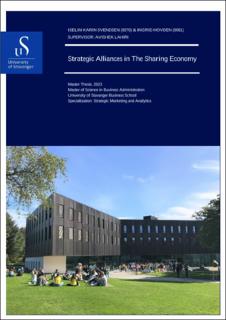| dc.description.abstract | This thesis aims to explore how sharing economy firms can improve profitability while remaining asset-light. Thus, we explored the possibility of forming strategic alliances with traditional firms. Currently, in academic literature, there is a lack of research on strategic alliances in the sharing economy. This emphasizes the need for a comprehensive study. Our research identified 42 strategic alliances between sharing economy firms and traditional firms. Moreover, the research revealed that joint distribution alliances were the most common type of alliance in the sharing economy. Thus, the topic was explored through an explanatory case study of the joint distribution alliance between Uber and Hertz, formed in America in 2016. This led to the following research question: “Can sharing economy firms and traditional firms create joint value?” Transaction cost theory was deployed to analyze the impact of the alliance on the firms’ profitability. More specifically, deploying transaction cost theory to determine whether the alliance impacted Uber’s revenue, costs, and the service providers’ transaction cost. Similarly, to evaluate whether the alliance impacted Hertz‘s asset utilization, revenue, and costs. The findings revealed that Uber’s mobility segment experienced significant growth and improved profitability during the first three years of the alliance. Similarly, the American revenue and total revenue increased in this period. In addition, Uber’s total costs increased, but the rate of growth decreased in the beginning of the alliance. However, there was a reduction in marketing incentives for the mobility segment. Nevertheless, the findings revealed that the alliance contributed to a significant financial gain for Uber’s service providers due to reduced transaction costs. Moreover, the findings also revealed that Hertz experienced an increase in American vehicle utilization following the alliance. In addition, there was an increase in revenue for both the American rental car segment and Hertz Global. Nevertheless, the findings demonstrate a slight increase in the costs for the rental car segment in America. Similarly, there was an increase in total costs. However, the rate of growth of these costs decreased after the first year of the alliance. In addition, depreciation of revenue earning vehicles and lease charges significantly decreased following the alliance. The findings also illustrated that both firms should have gained significant revenue from the alliance. Given that our findings align with transaction cost theory, demonstrating reductions in transaction costs and increased revenue and asset utilization, we conclude that sharing economy firms and traditional firms can create joint value through joint distribution alliances. | |
